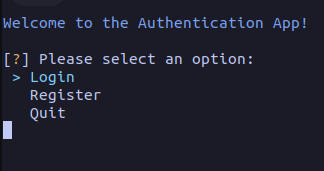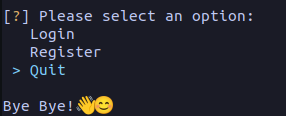This project is an authentication Command Line Interface (CLI) application built using SQLAlchemy to abstract the database operations and PostgreSQL as the underlying database management system. It utilizes Alembic for database migration management and follows the Model-View-Controller (MVC) architectural pattern for structuring the codebase.
Ensure that PostgreSQL is installed on your system before proceeding with the installation.
-
Clone the repository:
git clone https://github.com/AliHezarpisheh/auth-sqlalchemy.git
-
Navigate to the project directory:
cd auth-sqlalchemy -
Install dependencies using Poetry:
poetry install
This will create a virtual environment and install all required dependencies defined in the
pyproject.tomlfile. -
Activate the virtual environment:
source .venv/bin/activate (On Linux) OR source .venv/Scripts/activate (On Windows)
-
Set up the PostgreSQL database:
- Create a PostgreSQL database named
auth_db_sample_project.
- Create a PostgreSQL database named
-
Run database migrations using Alembic:
alembic upgrade head
This will create the necessary database tables based on the defined models.
-
You're all set! You can now run the application.
If you prefer using pip instead of Poetry, follow these steps:
-
Clone the repository:
git clone https://github.com/AliHezarpisheh/auth-sqlalchemy.git
-
Navigate to the project directory:
cd auth-sqlalchemy -
Creating and Activating a Virtual Environment: Before installing the project dependencies using pip, it's recommended to set up a virtual environment to isolate your project's dependencies. Follow these steps to create and activate a virtual environment:
-
Create a virtual environment using
virtualenvorvenv. If you haven't installedvirtualenv, you can install it using pip:pip install virtualenv
-
Create a virtual environment. For
virtualenv, you can run:virtualenv .venv
For
.venv, you can run:python -m .venv .venv
-
Activate the virtual environment:
- On Windows:
source .venv\Scripts\activate
- On macOS and Linux:
source .venv/bin/activate
You'll know the virtual environment is activated when you see the
(.venv)prefix in your shell prompt. - On Windows:
-
-
Install dependencies using pip:
pip install -r requirements.txt
This will install all required dependencies specified in the
requirements.txtfile. -
Set up the PostgreSQL database:
- Create a PostgreSQL database named
auth_db_sample_project.
- Create a PostgreSQL database named
-
Run database migrations using Alembic:
alembic upgrade head
This will create the necessary database tables based on the defined models.
-
You're all set! You can now run the application.
-
Navigate to the root directory of the application.
-
Launch the CLI application by running the following command:
python run.py
-
Upon launching the application, you will be presented with the main page.
-
To register a new user, select the corresponding option and follow the prompts.
-
You can then proceed to log in with your registered credentials.
-
Upon successful login, you will be greeted with a confirmation message.
-
To quit the application, select the "Quit" option.
Contributions to this project are welcome. Feel free to submit bug reports, feature requests, or pull requests via the GitHub repository.
This project is licensed under the MIT License. See the LICENSE file for details.
- SQLAlchemy
- Alembic
- PostgreSQL
- Poetry
- Inquirer








